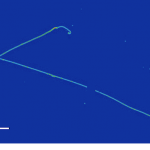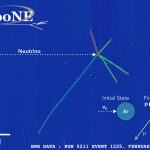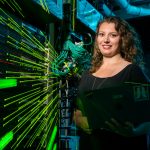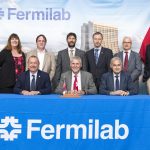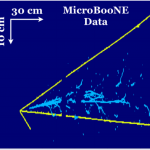From the University of Bern, May 2020: The University of Bern and Fermilab partner on three neutrino projects aimed at a thorough study of some postulated properties of the ghostly particle: MicroBooNE, SBND and the Deep Underground Neutrino Experiment, the latter to be considered the world’s ultimate neutrino observatory.
MicroBooNE
Scientists of the Fermilab experiment MicroBooNE have published the results of a search for a type of hidden neutrino — much heavier than Standard Model neutrinos — that could be produced by Fermilab’s accelerators. These heavy neutrinos are expected to have longer travel times to the MicroBooNE detector than the ordinary neutrinos. This search is the first of its kind performed in a liquid-argon time projection chamber, a type of particle detector. MicroBooNE scientists have used their data to publish constraints on the existence of such heavy neutrinos.
Scientists on Fermilab’s MicroBooNE experiment have measured neutrino interactions on argon with unprecedented statistics and precision using data on the resultant muons — in particular, the muon’s momentum and angle. The experiment features the first liquid-argon time projection chamber with the resolution and statistics to carry out such a measurement. Researchers will use the result to improve simulations of neutrino interactions. These improvements are important for neutrino experiments in general, including the Short-Baseline Neutrino program experiments and the international Deep Underground Neutrino Experiment, both hosted by Fermilab.
Kirsty Duffy, a Lederman fellow at Fermilab, says neutrinos are the most interesting particles in the universe. As a recipient of the Leona Woods Distinguished Postdoctoral Lectureship Award, she’ll have a chance to make her case in two talks she’ll deliver at the Brookhaven National Laboratory this November.
From Science, Aug. 8, 2019: Fermilab physicists are resurrecting a massive particle detector by lowering it into a tomblike pit and embalming it with a chilly fluid. In August, workers eased two gleaming silver tanks bigger than shipping containers, the two halves of the detector, into a concrete-lined hole. Hauled from Europe two years ago, ICARUS will soon start a second life seeking perhaps the strangest particles physicists have dreamed up, oddballs called sterile neutrinos.
From Forbes, Dec. 5, 2018: If there’s a fourth neutrino out there, Fermilab’s Short-Baseline Neutrino Program experiments will lead the way.

